

Khan Academy Enters Next Era With iPad App. Khan Academy, the wildly popular YouTube lecture series, has launched its free, new iPad app in Apple's store.

The enhanced version of Khan Academy includes time-syncing between devices--no Internet connection required--an interactive transcript of the lectures for easy searching, and a handy scrubber for moving between parts of the lectures. Perhaps more importantly, now that more schools have begun adopting Khan's lectures for their own classrooms, the iPad app could possibly replace or supplement textbooks, saving cash-strapped schools and students a lot of money. The major benefit of the app is offline learning. "If you're going on a road trip or if you're taking mass transit and you don't have cell service, or whatever, you can get the content," says Khan Academy Lead Designer Jason Rosoff. The iPad frees Khan Academy from the constraints of a laptop and Internet connection. InteractiveDesign. Interactive Design Interactivity Defined David Fortin (1997) has offered a definition of Interactivity that is appropriate across the differing contexts of information access, instruction, and performance support:
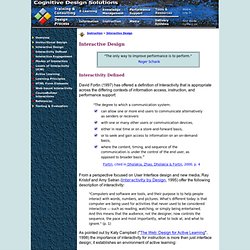
10 Benefits & 10 Concerns About the Shift to Digital Learning. Providence Rhode Island is fortunate to have Deborah Gist as commissioner, she’s a real chief for change.
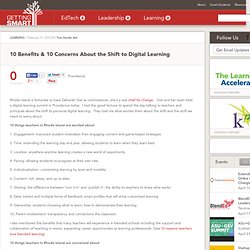
Gist and her team held a digital learning summit in Providence today. Revolutionizing E-Learning: Innovation Through Social Networking Tools by Paul Signorelli. Social media online offer another channel for blended learning designs, through collaboration and cooperation.
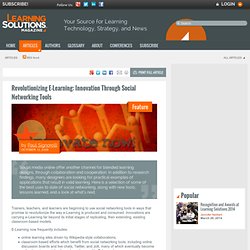
In addition to research findings, many designers are looking for practical examples of applications that result in valid learning. Here is a selection of some of the best uses to date of social networking, along with new tools, lessons learned, and a look at what's next. Trainers, teachers, and learners are beginning to use social networking tools in ways that promise to revolutionize the way e-Learning is produced and consumed. Innovations are carrying e-Learning far beyond its initial stages of replicating, then extending, existing classroom-based models.
E-Learning now frequently includes: What Would You Like to Learn on Your Own? Cultures / Languages. Audio CDs: English / Japanese: MP3, 128 Kbps (1 channels) | 03:07:19 Overal size: 306 MB | Genre: Learning Japanese Master Japanese with Learn Japanese - Word Power 2001.
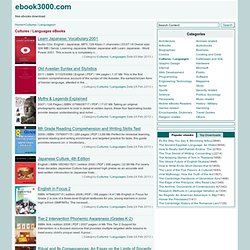
This e-book is a completely n... 2011 | ISBN: 3110253089 | English | PDF | 184 pages | 1.37 Mb This is the first modern comprehensive account of the syntax of Old Avestan, the earliest known form of Iranian language, attested in the ... 2007 | 128 Pages | ISBN: 0756628717 | PDF | 17.07 Mb Taking an original photographic approach to look in detail at certain topics, these four fascinating books provide deeper understanding and richer ...
Cloud-based Virtual Training. Learning Theories. It's time to start thinking differently about learning. We recently saw a tweet come across our learning lab that read, "Reading one good books makes you a lot smarter than skimming over 3,000 RSS feeds.

(via @gapingvoid). " While on the surface this comment makes logical sense and rings true to everything we have always been taught. Beware! Things are changing. Books are by no means the only source of credible information anymore. So, in answer to this tweet we simply state, it depends. If the book you are reading provides all the answers you are seeking around a specific topic, then yes it can be better than skimming 3,000 random RSS feeds. Keep in mind that just because we have traditionally been conditioned to believe that experts in a field write books, therefore books have all the answers, doesn't mean that experts don't also write blogs, add to communities, and generally contribute to the Learning Explosion taking place online. Prototyping in eLearning.
Digital Storytelling. Journals. 10Q: Helen Keegan. We are fortunate to have many innovators in education.
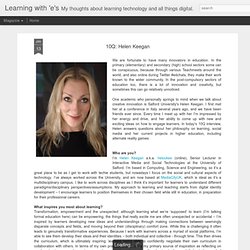
In the primary (elementary) and secondary (high) school sectors some can be conspicuous, because through various Teachmeets around the world, and also online during Twitter #edchats, they make their work known to the wider community. In the post-compulsory sectors of education too, there is a lot of innovation and creativity, but sometimes this can go relatively unnoticed. One academic who personally springs to mind when we talk about creative innovation is Salford University's Helen Keegan.
I first met her at a conference in Italy several years ago, and we have been friends ever since. Every time I meet up with her I'm impressed by her energy and drive, and her ability to come up with new and exciting ideas on how to engage learners. Who are you? I’m Helen Keegan a.k.a. heloukee (online), Senior Lecturer in Interactive Media and Social Technologies at the University of Salford.
Blended Learning. Social Media in e-Learning. Teaching with Google+ Stream This is like Facebook's News Feed, where the sharing happens.

Updates, links and other media from the people you follow will show up here. Posts aren't "hidden," but are "muted. "Circles This was a defining feature for Google+ when it was released -- a selling point that allows users to add people to different "circles" as a way of separating content, updates and the general mixing of different areas of your life. Whereas Facebook lumps everyone together in a single feed, Google+ streams allow you far more flexibility. Users are currently split regarding how well this works in application. Start Your Own Global Project. Last week I blogged about Our World, Our Stories which is a new global project my class is involved in. 2008 was the year that I began blogging and also collaborating globally with my students.
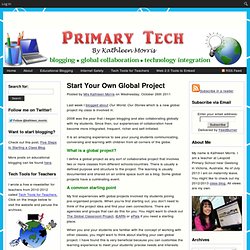
Since then, our experiences of collaboration have become more integrated, frequent, richer and self-initiated. It is an amazing experience to see your young students communicating, conversing and learning with children from all corners of the globe. What is a global project? I define a global project as any sort of collaborative project that involves two or more classes from different schools/countries. A common starting point My first experiences with global projects involved my students joining pre-organised projects.
Cool e-Learning Websites.